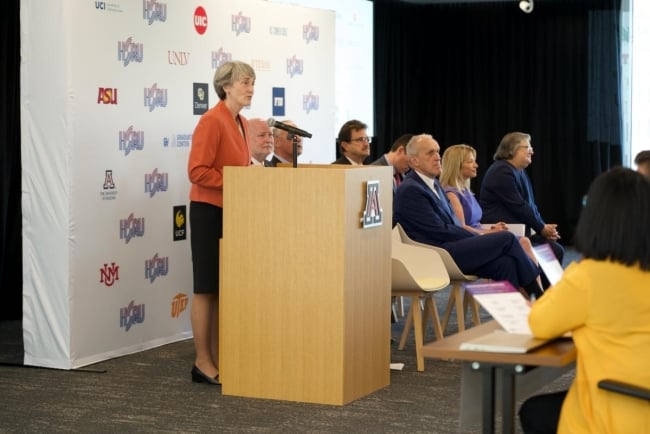You have /5 articles left.
Sign up for a free account or log in.

Hispanic-serving research university leaders gather in Washington, D.C., to announce their new alliance.
HSRU Alliance
A group of 20 research universities that are also Hispanic-serving institutions have formed an alliance to recruit more Hispanic doctoral students and faculty members to their programs.
The newly formed Hispanic Serving Research Universities Alliance, announced Thursday at a launch event in Washington, D.C., aims to double the number of Hispanic doctoral students and increase the number of Hispanic faculty by 20 percent at these institutions by 2030.
The leaders of these universities will share data tracking their progress and collaborate on grant proposals for collective projects in order to meet those goals.
Heather Wilson, president of University of Texas at El Paso and chair of the alliance, noted that Hispanics are 17 percent of the U.S. workforce but fewer than 6 percent of doctoral students nationwide.
“That’s not good enough,” Wilson said at the event. “No group is better positioned than we are to expand the pathway to opportunity and change the face of higher education in America, not just in one discipline but in all disciplines: humanities and arts, engineering and science, health and law, and business. We believe we are stronger together than any of us are alone.”
The group includes all universities with “very high research activity,” or R-1 categorization, and federally designated HSI status. Universities in the alliance span nine states and together serve 254,399 Hispanic students, 33 percent of their total student population, according to fall 2020 data from the U.S. Department of Education. The institutions also collectively graduated 1,451 Hispanic doctoral students, who made up 13 percent of their total doctoral graduates, in the 2019–20 academic year.
“I think this is a huge deal,” said Antonio Flores, president and CEO of the Hispanic Association of Colleges and Universities. The announcement shows that leaders at Hispanic-serving research universities recognize that “they don’t have very many professors in their institutions that look like the students that they serve” and have committed to building more robust pipelines.
A study published in the Hispanic Journal of Law and Policy found that the number of tenured Latino faculty grew by less than 1 percent between 2013 and 2017, and they now make up about 4 percent of total faculty nationwide. Meanwhile, Hispanic students made up almost 20 percent of students nationwide in 2017, according to a Pew Research Center analysis.
Even if the alliance succeeds in increasing the institutions’ Hispanic faculty by 20 percent, Flores expects the gap between Hispanic students and faculty members to widen as Latino communities in the U.S. continue growing rapidly and more Hispanic students enter K-12 schools.
“I think their goal is commendable and their intent is certainly in the right direction, but I think the numbers have to be much greater,” Flores said. “I think we really need to do a lot more than is proposed, but it’s not only up to those institutions. It’s up to everyone who wants to make sure the professoriate and the Ph.D. graduates reflect the demographics of the country and of the higher education student population. It’s not just HSIs.”
Alliance leaders have already launched two programs focused on engaging prospective and current doctoral students: the Computing Alliance of Hispanic Serving Institutions, which identifies Hispanic students interested in computer science to guide them toward Ph.D. programs in the field, and the Crossing Latinidades Humanities Research Initiative to support cross-regional research on Latino communities and run yearlong mentorship programs for second- and third-year Ph.D. students in Latino studies. Humanities students from different campuses will be paired with mentors and gather for a summer institute program to help them network and improve research and writing skills.
“Everything interconnects. It’s like a puzzle,” said Olga Herrera, managing director of the mentoring and research program. “They will be exposed to academic research, academic writing. They’ll have their mentors. The reality is jobs in academia are very competitive.”
She said the program will also offer the students connections and multiple opportunities to “strengthen their CVs.”
Cynthia Larive, chancellor of the University of California, Santa Cruz, said an advantage of an alliance of multiple universities is the ability to create programs that connect Hispanic graduate students from specific fields and help them feel less isolated. For example, Larive said, a given campus might only have one or two Latina doctoral students in its chemistry department, but the alliance could potentially connect Latina chemistry students across the country.
“Bringing together cohorts of people who can support each other and form a network of colleagues that they will have throughout their lives and their careers—I think that’s a really important concept,” she said.
Another benefit of the alliance is having regular opportunities to exchange best practices, Wilson said. She noted that the University of Texas at El Paso has found that Hispanic students who participate in undergraduate research programs and develop strong working relationships with faculty members and administrators are more likely to go to graduate school. These findings could prove useful to other university leaders.
Javier Reyes, interim chancellor of University of Illinois at Chicago, believes the alliance can also have a ripple effect on universities with smaller Hispanic populations. As alliance universities graduate more Hispanic doctoral students, he hopes some of them will get hired as professors at non-HSIs, empowering Hispanic students at those institutions to consider graduate education.
“We’ve won when this effort has now provided a wide set of Ph.D. students into institutions that are not Hispanic-serving institutions only” because then “any Hispanic student, any Latin student, can see themselves in higher ed across the spectrum of the great universities that this country has,” he said.
He also noted that increasing the number of Hispanic faculty members can diversify higher education leadership, as some of these scholars rise up through the ranks and become administrators.
Kim Wilcox, chancellor of the University of California, Riverside, said the alliance signifies a new level of awareness among higher ed leaders.
“Ten years ago, there was very little conversation in America about student success, about upward mobility,” he said. “In fact, there was almost none. We haven’t had this kind of national conversation about the doctorate, about Latinx representation in the faculty, about the importance for knowledge but also the importance for role models for all those students. I’m energized not so much about the projects and the goals, which are fine. I’m more energized about the change in the national conversation. That’s a real opportunity.”









